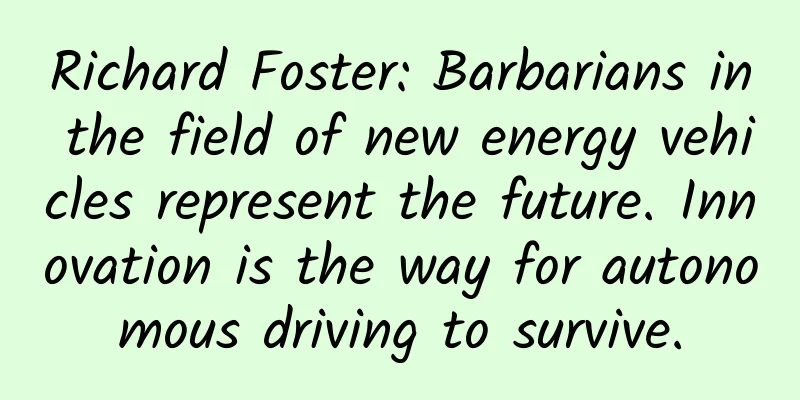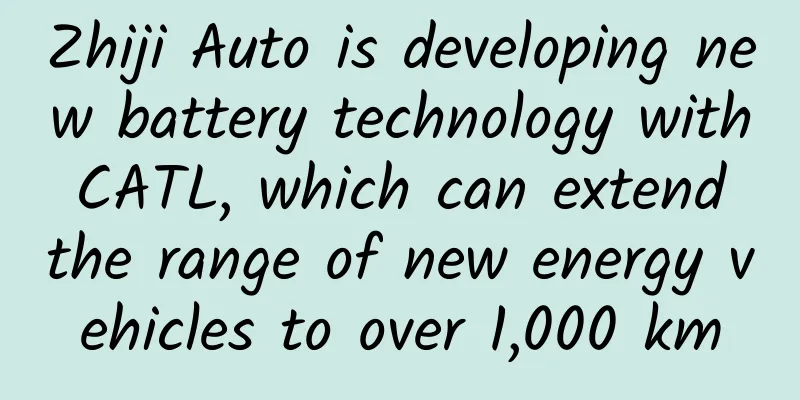Richard Foster: Barbarians in the field of new energy vehicles represent the future. Innovation is the way for autonomous driving to survive.

|
In recent years, with the recognition of the energy crisis and environmental degradation, the new energy vehicle market has ushered in a breakthrough development. Now there are many future-oriented new technologies, and many new features have emerged in the automobile market. However, no matter what industry or market, there will be risks, and where there is a market there is competition. The market environment is ever-changing. Facing risks and competition, where will the future of new energy vehicles be? On December 17, the 7th Global New Energy Vehicle Conference (GNEV7) opened. At the conference, Richard Forest, author of "Creative Destruction" and retired director of McKinsey, delivered a speech. Richard Forest introduced the development of autonomous driving and new energy vehicles, as well as the current market situation and some new trends from the aspects of risks and competition. Richard Foster, author of Creative Destruction and director emeritus of McKinsey Richard Forster took fishing as the starting point of the topic and used Norway in 1700 as an example to explain the relationship between benefits and risks - winds, waves and undercurrents are dangerous, but beneath the dangers are abundant fish schools, and if you want to catch big fish, you have to take risks. In the Forbes magazine founded by BC Forbes in 1917, only 39 of the top 100 large companies in the United States survived 70 years later. In the past 70 years, 82% of the companies played a very important role in the US economy, but eventually failed. The market is changing all the time, and competitors are constantly coming one after another. Richard Foster cited the example of HP: "HP's price-to-earnings ratio increased twenty times in just twenty years. There is a book called "Built to Last" that says this is the secret to business sustainability, but then another book was written called "How Powerful Companies Fail and Fall." Therefore, long-term success is unlikely. The biggest variable is risk, so what we need to do is to control risk." Richard Foster also mentioned the "concept of barbarians", "barbarians are people outside the industry", and believed that whether in the past, present or future, we will face barbarians at the door. The new energy vehicle market faces the same situation: new companies continue to pour into the market every year, and these are all competitions to be faced. Richard Foster combined the relationship between Gulliver and the villains in "Gulliver's Travels" to expound a point of view: "This is not a small company challenging a big company, but many small companies competing with a big company. So maybe many of you here are small and medium-sized enterprises, but small and medium-sized enterprises will grow into very significant large companies in the future. At present, you are the new barbarians, and you represent our future." The new energy vehicle industry is constantly undergoing new changes, with companies from different industries pouring into it. This is a complex situation. If you want to make new energy vehicles a giant in the industry, then the challenge is how to maintain your advantage in the fierce competition. Competition is not limited to price or output, but more importantly, it comes from some new areas, such as new technologies, new commodities, and new supply chains. How to operate, how to control, how to create, and how to eliminate are four elements that need to be considered. Regarding the autonomous driving car market, Richard Foster believes that many new companies are not from the traditional automotive field, but from aerospace, defense and even other industries. The sources of competitors have included more fields, which has also brought more complexity to the entire competition. Therefore, the challenges now are how to balance, how to achieve sustainable development, how to face changes and how to control risks. Finally, Richard Foster concluded: In the face of current and future challenges in the industry, we must now make some disruptive innovations to gain an advantage over attackers. The following is a detailed transcript of Richard Foster's speech: Good morning everyone, what do I want to introduce to you today? I will introduce to you some new trends in autonomous driving and new energy vehicles and the future. There are also some new trends in the entire market and market, because we know that there are many new technologies that are future-oriented, and many new features have appeared in the automobile market. In fact, let's first focus on Norway in 1700. This is a very northern area of Norway. You can see that there are very strong monsoons from the west and cold air from the east. You can see that there are very strong waves here. In the middle of the waves and storms, do you see this small boat? This boat is about 20 meters high, and you can see that the waves are also 20 meters high. It is very dangerous. Why does this boat want to go here? Why does it take this risk? You can see that there are some undercurrents under the sea, which can actually put the boat in a very advantageous position. That is to say, these undercurrents will bring the fish on the seabed to the surface of the sea. If you want to fish, you have to take this risk. Doing this fishing business is also the risk that everyone has to take if they want to catch big fish today. The person in the picture is Ford. He founded a magazine called "Forbes" more than 100 years ago. You may know that this is a very famous business magazine in the United States. He had just started at that time and hoped to have something attractive to attract all readers. He counted 100 companies in the United States at that time. You can imagine that in 1917, there was not much understanding of the overall economic environment, and there was no so-called big data. The Federal Reserve was just established four years ago, and there was not much existing information. We did not have the so-called corporate income tax or government records. We did not know how some large companies in the United States performed at that time, and we had very little understanding of the entire market. At this time, "Forbes" magazine counted the top 100 large companies in the United States. They also wanted to predict which political and economic factors would affect the survival rate of these companies in the next four or five years. Afterwards, he compiled a new list to see which of the 100 companies survived. We see that only 39 companies survived after 70 years. It can be said that nearly 60 or 70 companies disappeared from the market. It doesn’t mean that they all went bankrupt. Some were merged or acquired by other companies. You can see that these 39 companies are not ranked in the top 30 or 40. If we look at the net assets of these companies, they are hardly among the top 100 in the United States. We see in the new data that 82% of the companies in the past 70 years were actually very important to the US economy, but they failed. Only these 18 companies survived. Everyone will wonder if we can invest in these 18 companies? Can we guarantee that they will survive in these 80 years? In this way, we can get better returns by investing in these companies instead of investing in index funds. We can look at these long-term technologies and see why these companies can remain active in the market and why they can survive. In fact, there are very few companies that can survive for a long time. We need to understand that this is also the case in the new energy vehicle market. Let me list a few companies for you to see how difficult it is to survive in the market. For example, the average annual return for shareholders of American companies is 7.5%. You can see that the best performing company is General Electric, which has a return of 7.8. You can see that it is only slightly higher than the average. In fact, in the past 30 years, if you invested in General Electric, your return might actually be reduced by 10% because its performance is not that good. Look at the remaining investment options and other investment companies. The next company is Kodak. Do you remember Kodak? Kodak produced film, and it has gone bankrupt. Who killed Kodak? It was not a film company or a camera company, but Nokia. So this was a company completely outside the industry, but a company outside the industry killed Kodak. As time goes by, this story keeps repeating itself. So when we look at this list again, we find that no company can exceed the long-term growth rate of the United States, and all the companies marked in red no longer exist. General Motors is marked in yellow because it has been reorganized. I remember that it was also very problematic at the time. DuPont's business also declined, and there were not many businesses left in the list at that time. This is the information I want to tell you. We can see that many companies that were on the list just ten years ago are no longer on the list, and have disappeared. At the same time, these companies have re-entered the list in the past ten years, so the world has become very different after ten years. In just ten years, the world we live in has changed dramatically. This is the same result presented from another angle. The white part represents the 18 companies whose performance is better than the general market index, and the red part represents their performance is worse than the market average. These are the 18 companies. These 18 surviving companies have been performing worse than the market average for many years. They have only been better than the market average in a few years, so this actually reflects that the new competitors they face have better performance, whether they are from the United States, Europe or China, some new competitors have better performance. At the same time, we also believe that companies can be built to last for a long time. Here we look at a company, HP, whose price-to-earnings ratio has increased twenty times in just twenty years. At that time, there was a book called "Built to Last" saying that this is the secret of our business continuity. This book was published at the time, but then another book was written, "How Powerful Companies Fail and Fall", so long-term and sustained success is unlikely. The biggest variable is risk, so what we have to do is to control risk. We also know the S&P 500 index. The S&P 500 index is a list of companies that are the best in various industries in the United States. Since the first S&P index was established in 1957, there have been more than 5,000 companies in the index, and the changes in these companies are different. One percentage point refers to the percentage of companies in the S&P 500 index that have changed. These companies will naturally change, but if there is a 5% change, the entire list will change in 20 years. The horizontal axis refers to time, so we see that from 1932 to 2007, there was a 1% change at the beginning, which means that if you work in this company, it is a very good thing for your children to work in this company. But now you may not work in the same company as your parents, and your children may not work in the same company as you, which shows that our current environment is very different from that time. I think in another ten years, 75% of the companies in the S&P 500 index will change, and these companies will not appear in the list. This is the historical evolution and change related to the concept. This is a small understanding of Chinese culture. The ancient Chinese concept of yin and yang, translated into English, says that it was born from the chaos of the universe. I think this is the essence of the universe. Herodotus, the father of Western history, once said, "The wood of history is to preserve the deeds of Greeks and barbarians." Barbarians are people outside the industry. We call them barbarians for what they do, and it is crucial to understand why they fight each other. This is the root of the continuous changes from 500 BC to the present. If we go back to the 12th and 13th centuries, when the Islamic world was at its peak, there was a famous scholar called Ibn Khaldun who said, "If a world becomes a great civilization, it will decline rapidly after reaching its peak." At that time, in the decline period after the peak, these leaders were conquered by barbarians. So these great civilizations were conquered by barbarians, so we are also facing barbarians at our doorstep, and this has been the case in history, it is the case now, and it will be the case in the future. Some long-lasting companies are called Masala companies. The European Masala company I can think of is a company founded in 1472. Of course, its current situation is not very optimistic. There are also some in China. The one I know is Shandong Pennsylvania Bohai Piston Company. This company was founded in 1651. I don’t know if there are any representatives of Piston today. If there are, I would like to meet them. They are really very old. There are also long-lasting companies in China. There are also companies that have survived for a long time in China. In the United States, the following company can be called a century-old store. They currently play a very important role in the economy and have many employees. The same is true in China. Of course, the history of these Chinese companies may not be as long as that of American companies. So there are many companies that have lasted for a long time in the economies of both China and the United States. So why is this happening? When we in the West explain the economy, we usually talk about the battle between David and Goliath. David is a giant, and Goliath only has the skill of throwing stones. In the end, Goliath won. Another example is the fight between Gulliver and the Lilliputians. This is not a one-on-one fight, but a fight between many small people besides Gulliver. When these small people unite, they can defeat the giant. So I think there are many such Lilliputians and small people in our industry. For example, we have 20 new companies every year, and they are all the competition we face. So this is not a small company challenging a big company, but many small companies competing with a big company. So many of you here may be small and medium-sized enterprises, but small and medium-sized enterprises will grow into very significant large companies in the future. And I think no company can continue to be more innovative than the entire market. I think this is impossible, because every year there are new companies pouring into the market and there are new innovations, and this is the big trend we need to grasp. The first company that competes with you is not a single company, but a group of companies. Some of these companies may be in China, some in the United States, some in Europe, some in Japan, and some in India. But I think this is the case when competing with companies in Europe and the United States. So these are all new barbarians. At present, you are the new barbarians, and you represent our future. I will go through these PPTs very quickly because we have limited time, but I want to show you the returns of these companies studied in the United States. In the United States, the return rate is 52.1%, and the market return rate is huge. There are 17,647 companies in the private market. Do you think the competition from the United States comes from listed companies or non-listed companies? It must be the private sector. China is actually exactly the same. According to the data I read, there are 3,195 listed companies in China, but there are 171,480 private companies outside of them, which means that one listed company has to deal with about 54 private companies. So I think it is these private companies that will drive change. New energy vehicles are a very complex industry. It includes many parts, including some parts of the traditional automotive industry, including cars and trucks, passenger cars, and some aviation companies, including military aircraft companies and airlines in the United States. At the same time, all airlines, including T&A, seem to have problems. At the same time, there are regulators, and the regulatory policies of regulators are constantly changing. At the same time, there are state-owned airlines, which have changed the situation of competition in the United States. So I think the same scenario will occur in the new energy industry. It is not a winner-takes-all situation. There will be changes in the next ten or twenty years, because it depends on what kind of new energy vehicles we will produce, what kind of services they will provide, what kind of regulatory policies they will face at the time, and what kind of ecological environment you are in. Of course, everyone will be more familiar with which companies are currently involved. In fact, it seems that all kinds of companies have joined in, not only manufacturing companies but also new companies, and new changes are constantly taking place. This is a responsible and complex situation. As Gulliver, the challenge he faces is how can we still maintain our advantage in this situation? And in the absence of guarantees, we also need to remain vigilant. We need to see where the boundaries of the situations we can imagine and the unexpected are, and how we can make good responses and preparations. The person who could predict this the most was Austrian economist Joseph Schumpeter. I have quoted many of his words before, and I also found that those present here may be very familiar with these images and words. In fact, he said some very important words before. He said some views on capitalism, such as some disruptive innovations in creating capitalism. We need to think about what capitalism contains and what all these capitalists care about. He believes that the reality of capitalism is not just about the competition of prices or output, but comes from some new areas, such as new technologies, new commodities and new supply chains, and the challenges brought by these competitions. So usually when we discuss these issues, we will look at how the current capitalist system manages the existing structure and how we can break the existing shackles to create some new technologies and new challenges. This is like the three-dimensional realm of the Tripitaka in Indian statues. In fact, the author of "Alice in Wonderland" also mentioned four aspects: how to operate, how to control, how to create, and how to eliminate. Usually we don't think about how a company is eliminated from the market. This is also a very important topic. We need to think about how we can recombine these four elements to imagine the challenges we will face in our careers and in our own market development. Finally, I will give you a detailed introduction page. This is the chart of our current industry. You can see that in the market for autonomous vehicles, many companies and many new companies are not from the traditional automotive field, but from aerospace, defense and even other industries. This is also what we need to think about. Regarding the source of our competitors, it has included more fields, such as airlines, defense, etc., which also brings more complexity to the entire competition. So the challenge we are facing now is the need to rebalance, hoping to find a balanced way to achieve sustainable development, change and risk. These three elements may also be discussed further today, that is, how to achieve sustainable development, how to face change, and how to control risks. Finally, I want to mention a sentence from Cheston. He said, this is also a famous quote from more than a hundred years ago. He said that the biggest problem in the world is not whether the world is reasonable or unreasonable. Even if it is reasonable, the problem still exists. Sometimes we see that the world is tending to be reasonable, but there are still some unreasonable factors. And usually life is illogical, but he has laid some traps for logicians. It seems to be very regular, but in fact there are many hidden traps and challenges. This is also what we are facing now. The turmoil of life is still waiting, or the wild indulgence is ready to move. This is the challenge we face in the future, including the challenges we are facing in the industry now. We now have to make some subversive innovations to gain the advantage of attackers. Thank you everyone! As a winner of Toutiao's Qingyun Plan and Baijiahao's Bai+ Plan, the 2019 Baidu Digital Author of the Year, the Baijiahao's Most Popular Author in the Technology Field, the 2019 Sogou Technology and Culture Author, and the 2021 Baijiahao Quarterly Influential Creator, he has won many awards, including the 2013 Sohu Best Industry Media Person, the 2015 China New Media Entrepreneurship Competition Beijing Third Place, the 2015 Guangmang Experience Award, the 2015 China New Media Entrepreneurship Competition Finals Third Place, and the 2018 Baidu Dynamic Annual Powerful Celebrity. |
<<: Are you still missing an ecosystem to become a “great” Internet company?
>>: Faraday Future is sued by Fuzhuo for $10 million in overdue payments
Recommend
Permission issues in Android
In Android programs, permissions must be declared...
Which is cooler, iced coffee or iced cola? The correct answer is...
On hot days, besides air conditioning, the best t...
400 activation and charging standards, how much does it cost to activate a 400 phone number?
400 telephone numbers are not completely free num...
Scientists have given the newly discovered pangolin a temporary name of "mysterious", and you may never guess why...
Not long ago, the team led by Professor Yu Li fro...
Advertising strategies for the four hot-selling industries during Double Eleven!
Double Eleven is approaching. In the e-commerce b...
Nut 3 mobile phone: Will this be Luo Yonghao’s last product to compromise with the market?
On April 9, at the gymnasium of Beijing Universit...
Italy urgently seeks help from China! Why ask for help? Attached is the latest number of confirmed cases in Italy
Italy is one of the countries most severely affec...
A clear, complete and reusable solution for recalling lost users
Peter Drucker, the father of modern management, o...
Why do young women who don't smoke get lung cancer? The reason may not be what you think!
During the National Cancer Prevention and Treatme...
Digital integration solution based on flink
1. Overview In actual privatized IoT platform pro...
Does the TV game hall interception of CP bring birth or death?
Searching for "TV game channel revenue shari...
Is it contradictory to protect a certain species with protecting biodiversity?
A few days ago (May 22) was the International Day...
Electric Technology Car News: Reduce displacement without worrying about power. What is the magic of the new Sagitar?
Want to save fuel? Reducing displacement is the s...
Have you seen the code written by Lei Jun 22 years ago?
As the founder, chairman and CEO of Xiaomi Techno...
Technology News丨my country's easternmost high-speed railway will be officially opened tomorrow; Omicron "super-spreading event" occurred in Norway
【Today’s cover】 December and March are the best t...









